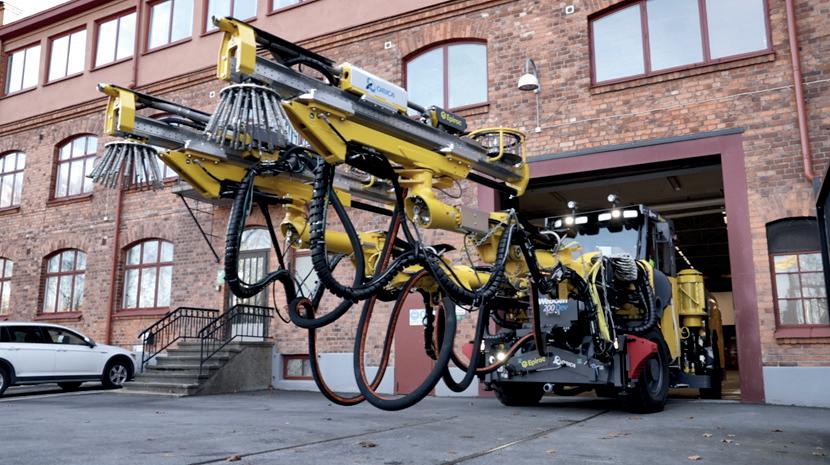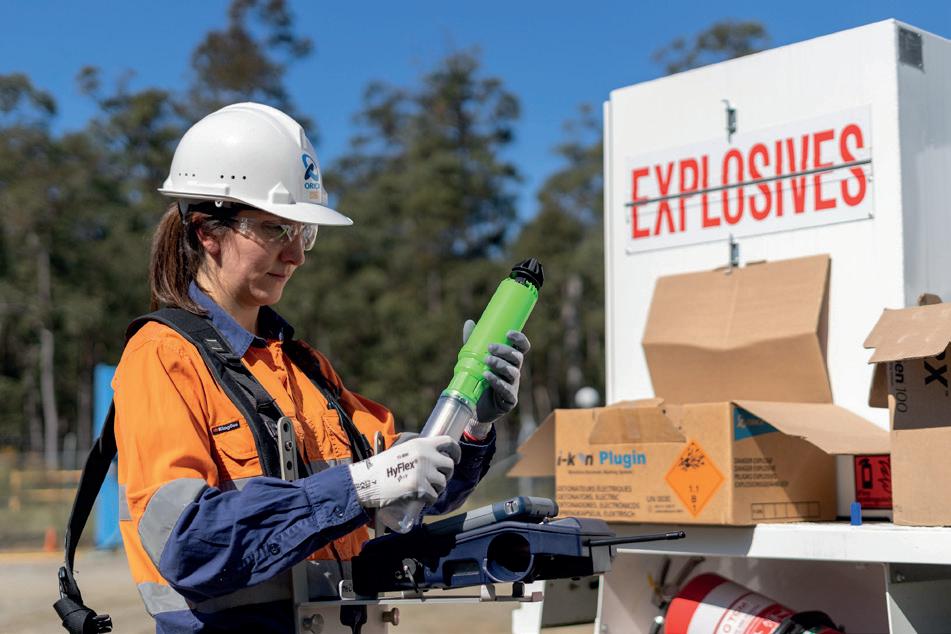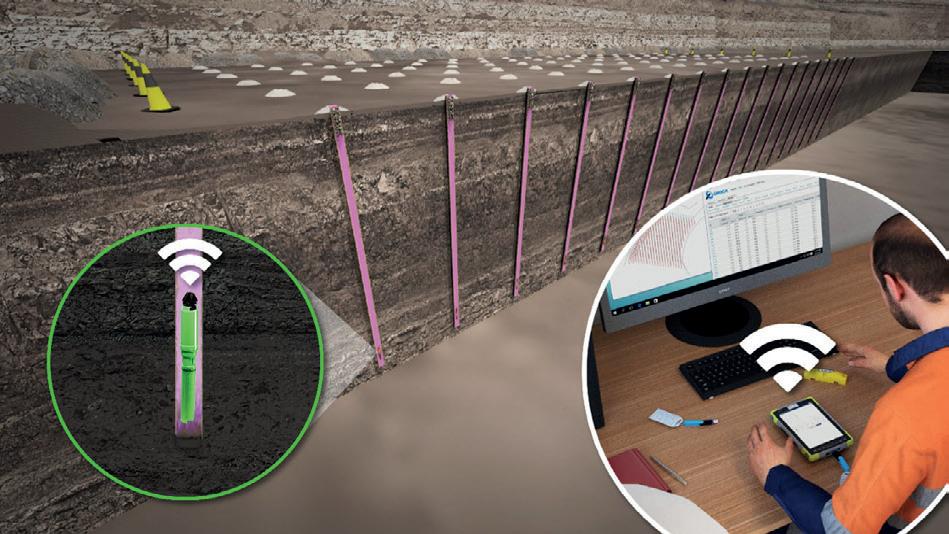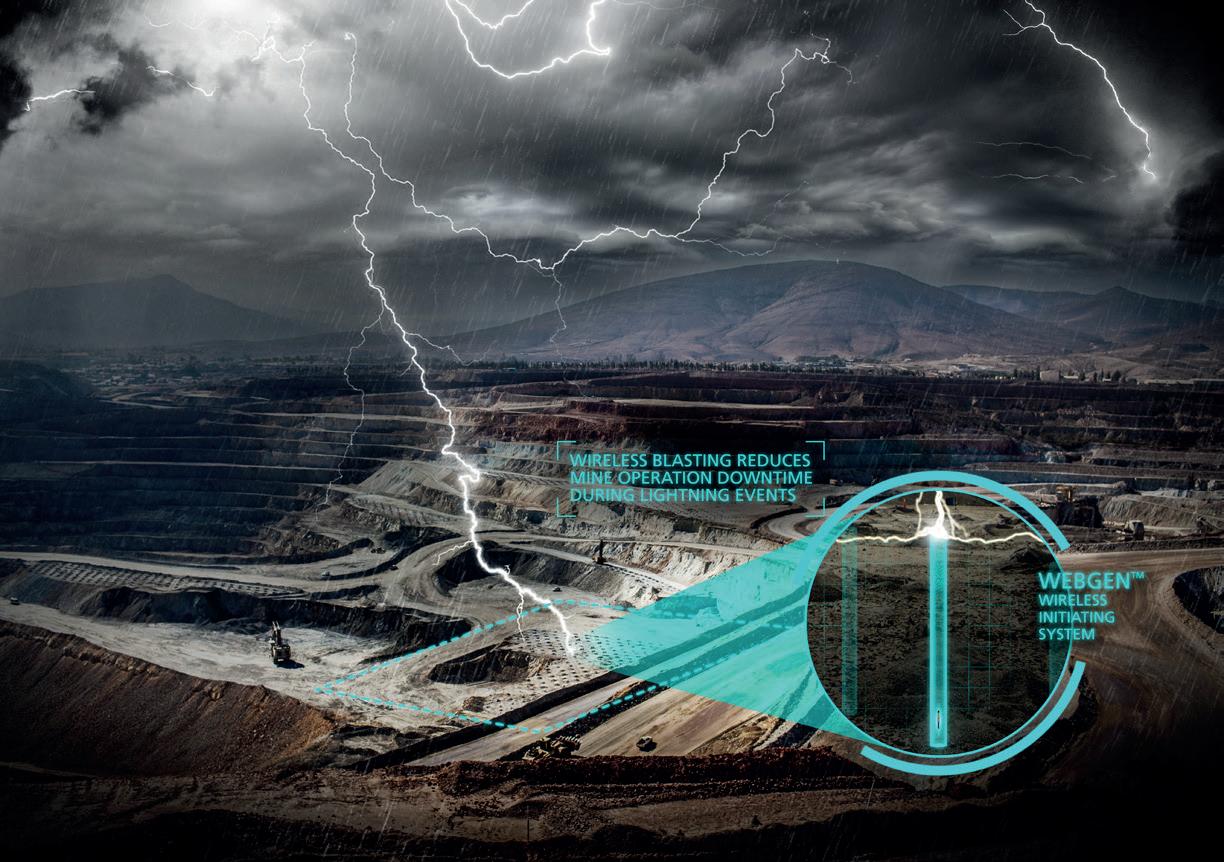
11 minute read
Blasting The Surface


Geoff Stevenson, Orica, Australia, discusses how wireless blasting can benefit surface mining operations.






Wireless initiating systems allow for groups of in-hole primers to be wirelessly initiated by a firing command that communicates through rock, air, and water. This eliminates the need for down-wires and surface-connecting wires, enabling completely wireless mining methods and blasting techniques that are safe and reliable – further reducing risks and operating costs while, at the same time, increasing productivity benefits. This significant step-change in blasting technology has fundamentally shift ed the industry’s approach to blasting and mining and opens up opportunities for a much wider array of markets and mining applications.

Wireless blasting
Since the launch of Orica’s WebGenTM 100, the world’s first wireless initiating system, in early 2017, Orica has successfully completed more than 2500 blasts using the wireless technology in both underground and surface mines around the world.
Now, Orica has announced the second generation of this technology. Built to deliver market-leading safety and reliability, the new WebGen 200 incorporates world-first wireless technology; engineered with enhanced capabilities and security to meet the extremes of mining conditions, with greater versatility to adapt to the needs of both surface and underground customers pushing the boundaries of mining.
Orica’s new technology has been designed in line with customer needs and feedback, as they look to further improve safety and productivity across their operations.
WebGen 200 will be available as four product variants and includes a wider range of booster weights; opening up new segments, applications and opportunities, in both surface and underground mining. It is a critical enabler to Orica’s vision of transforming how drill and blast is used to unlock mining value across the value chain, utilising integrated digital and automated technologies to create safer and more productive operations for customers.
The system leverages advancements in digital technology to deliver sophisticated features including digital inventory management, delay adjustments before blasting, an improved user interface and increased quality assurance. Reliability is front and centre, with the primers able to endure even greater dynamic pressure and the ability to sleep the product in the ground longer.

Figure 1. AvatelTM at Epiroc’s factory in Örebro, Sweden.

Figure 2. A WebGen Specialist assembling a WebGen 200 Surface primer ready for encoding.
WebGen 200 Surface and WebGen 200 Surface Pro are designed for surface mining applications, with the latter designed for extreme blasting conditions, allowing for the use of innovative blasting techniques, such as: multi-stratum blasting, mining schedule flexibility, and lightning risk reduction.
The WebGen 200 Underground Pro is suited to production blasting, while the WebGen 200 Underground Dev has been designed for mechanical assembly and handling, and enables the automation of underground development charging with AvatelTM .
The WebGen 200 Encoder has been ergonomically designed for easier handling – the primer is now placed in a side opening without the need for alignment, and the DRXTM is encoded using near field communication (NFC). This can be completed with or without the booster attached for either batch or at-hole encoding. The encoding tablet is a Juniper Systems Mesa3 with the Windows 10 operating system, which can be removed from the encoder body as required. The new encoder takes advantage of WiFi, NFC, and RFID for data exchange and to streamline workflow, and also programs every individual WebGen primer via an encrypted code specific to the mine site.
The encoder is a key component in managing the safety and security of the system, and programs each wireless primer with three important pieces of information.
The first code is a unique blast identity number (BID), which is exclusive to the mine site and is assigned to specified groups of primers, which will sleep, wake, and fire together as a single blast.
The second code is the blast proximity identity (BPI), which is recovered from an RFID beacon that is in the blast location.
The third code is the DRX ID (UID) and it is linked to delay time and hole ID, and allows the all-new capability of deleting primers or changing the delay times of primers in a blast; it also records component IDs for blast inventory management (BIM).
The BIM senses an RFID tag in the DRX and is traced to a blasthole; soon, it will also be possible for cases of detonators and primers to be scanned going in and out of magazines (and other sensitive locations) – during encoding, they too will be associated with a blast hole. Also coming soon is a
misfire detection system, which will trigger an alert if a misfire has occurred in a blasthole.
There are five antennas available with the wireless blast system, which means the effective transmission range for the firing signals can be more closely controlled to the work area. The antennas have been designed for more convenient handling, with hinged joints to reduce bulk where needed, and they are further hardened to withstand mine site conditions.
The new hardware, software, and primers come together as a versatile and reliable system that is easily integrated into any operation to allow miners to think differently about their ways of working and operations.
Breaking new ground in surface mining
While WebGen 100 was initially positioned for use in underground applications, it is now increasingly being adopted in surface mining to complete successful surface blasts across three continents. WebGen 200 presents an opportunity to overcome one of the industry’s most constraining limitations, which is the relatively fragile physical connection to each primer in a blast. Wired systems have a large physical footprint and are susceptible to damage at every point along the connecting lines, so removing this barrier significantly increases reliability.
The potential for misfires, due to downline damage in wired systems, has commonly led to the application of redundant initiation systems and can prevent loading of adjacent blast patterns, due to possible fly-rock damage. These contributing factors increase blasting costs, reduce mine efficiency, and limit blast productivity. Wired systems in priming, loading, stemming, and tie-in activities require precautionary measures to protect wired connections, adding to manpower needs and cycle time.
WebGen 200’s fully wireless technology simplifies bench operations in surface mining with no tie-in process, and reduces on-bench resources, inventory, and misfires that occur due to line damage or cut-offs, slumping, or operator error. Stemming costs are also reduced and back-up inventory is eliminated through this wireless system.
The absence of downlines also removes the interaction between heavy vehicles and people, in order to protect initiating systems and reduce exposure to on-bench hazards. The elimination of the tie-in process means spotters are not required to protect downlines nor exposed to dust and dangers from stemming operations.
The second generation also paves the way for innovative mining practices to be considered, such as turning a WebGen 200 loaded blast strip into a temporary haul road, providing greater scheduling flexibility to operations. This enables haul trucks and other mining equipment to tram over the loaded blastholes, providing improved efficiencies in the load and haul process; and greater productivity to mine operations through flexibility in mine pit scheduling, delivering increased vertical advance in surface mining operations. With increased flexibility in pit planning and blasted inventory, mine operations enabled by WebGen 200 can prime and load larger single blasts, as well as eliminate firing window variability.

Figure 3. WebGen 200 fully wireless initiating system has no downlines and surface connections to the detonator.
Figure 4. Wireless blasting reduces mine operation downtime during lightning events – eliminating all potential initiation pathways and risk of unplanned explosion.
Untethered blasting opportunities
Being truly wireless means benches with stemmed holes loaded with WebGen 200 primers have no wires or signal tubes on the surface – all explosive materials are located within the blastholes in the ground. This eliminates the most likely hazards associated with vehicle interactions with explosives. Other situations considered potentially hazardous were also investigated. Detailed theoretical and practical investigations have concluded that heat and pressure are rapidly attenuated by

the ground; therefore, fire, heavy equipment forces, and rockfall impacts will not have any effect on the primers or Orica bulk explosives, due to the absence of downlines and surface connecting wires. The magnetic field induced by high current trailing cables does not carry the correct digital code to wake up and fire a WebGen unit, and the magnetic field will be too weak to cause corruption of the DRX that might lead to a misfire. Along with WebGen 200, a number of operational controls will be necessary to ensure there is no risk, including priming practice, blast demarcation, and changes to excavation practices.
Lightning risks and delays a thing of the past
The wireless blast technology enables the elimination of lightning-induced explosion hazards in loaded blastholes, including any holes that remain unstemmed, by removing the initiation pathway provided by downlines and surface connecting wires. In the event of approaching lightning storms, a mining exclusion zone is placed around the loaded blast or, in some cases, the blast is cut short and immediately fired. With the removal of all initiation systems from the bench surface, mine operations no longer require a wide lightning exclusion zone to continue safe operations, thereby avoiding long periods of inactivity or causing the firing window variability that is subject to the use of conventional initiating systems.
With bulk explosives and initiating systems at a minimum safe depth of 3 m below the surface, and with the absence of lead wires, the temperature, pressure, and electric charge associated with a lightning strike has no significant effect on the explosives loaded in the blast holes; rather, the energy is rapidly attenuated by the earth. The magnetic field induced by lightning will not carry the correct digital code required to activate a WebGen unit for firing, so in the event of lightning in the vicinity, the bench will still need to be cleared of personnel, but there will be no explosion risk.
Bringing mining efficiencies to the surface
The technology can also improve productivity in surface mining by loading multiple decks in a single pass. This approach offers improved utilisation of drill and blast and load and haul capacity. In the case of drill and blast, the second generation technology allows for bench preparation to be reduced and drill metres to be increased through fewer relocations of the drill. Explosive loading is faster and scheduling blasts are no longer constrained by the drill and blast process. The load and haul operations are also more productive, with continuous access to broken stock, less relocation of equipment, and a smaller overall active footprint.
Along with WebGen 200, additional operational controls will be required, which include more accurate drilling, monitoring explosives deck location, monitoring stemming, and primer location; and an excavation management plan that ensures standoffs and relative levels are maintained, supported through technologies that are currently in use.
Case study: Brazil
Salobo Mine (Vale, Brazil) was interested in eliminating safety related damage to lead wires during stemming and reducing the loading crew’s exposure to dust and heavy vehicles. Two demonstration blasts were planned – one of 350 holes and a second of 190 holes.
These blasts were able to demonstrate: The elimination of safety incidents related to wire damage, which is a critical requirement for the operation. Removal of interaction between heavy vehicles and people during stemming. The elimination of exposure to dust during stemming and lead wire damage. A 50% reduction in stemming time, as manoeuvrability was unhindered by lead wires.
While WebGen also allows the elimination of lightning exclusion zones around loaded blasts, this was not able to be assessed as no lightning events occurred during the trial period.
Once the loading of the second blast was completed, the loading equipment (mobile manufacturing units – MMUs) were driven over a temporary road which ran diagonally through blast holes on the bench. The objective was to demonstrate that loaded WebGen blasts can be safely used as roads without impacting on blast performance.
Vale and Orica are currently exploring opportunities to further assess the benefits that WebGen would bring to scheduling flexibility and overall production from the pit.
Moving the mining industry forward
The WebGen 200 development programme is progressing according to plan, with comprehensive product verification and validation testing now complete. Field trials of the WebGen 200 system began in September 2021 and will be completed by December 2021, across multiple mining segments and regions in Australia, Canada, Latin America, and Europe.
Conclusion
Artificial intelligence and advanced machine learning capability will interpret real-time data to design even more predictable blasts. As operations become more digitally connected, more workflows will become fully automated. As mines go even deeper, and ore becomes even harder to reach, ongoing advances in automation, digitisation, wireless blasting technology, and data analysis will deliver not just better returns, but also better environmental and social outcomes.










